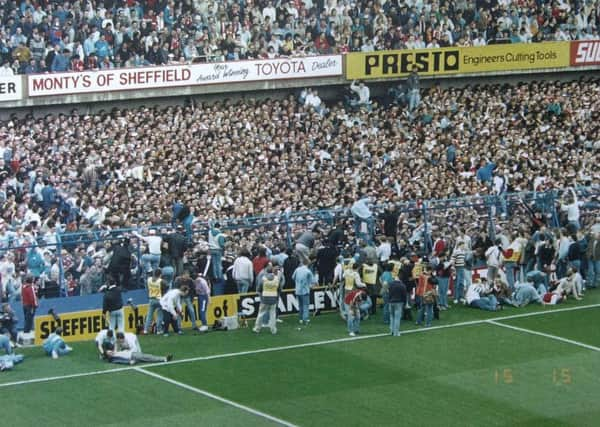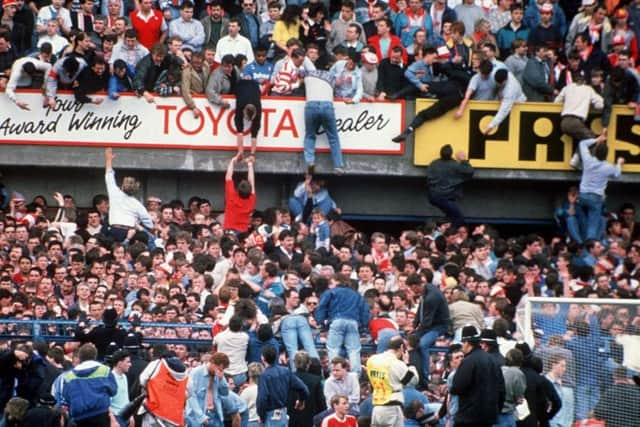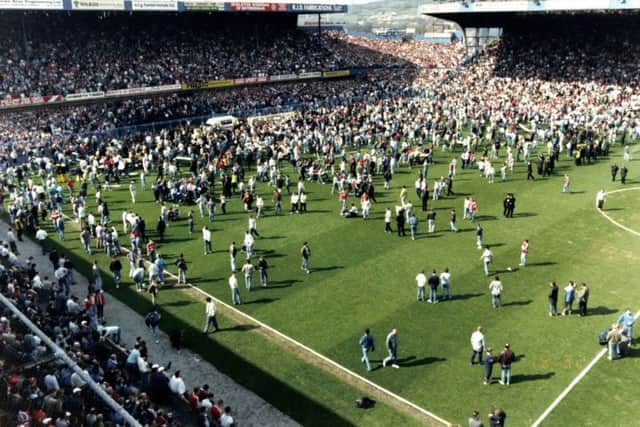Hillsborough officer denies trying to shift blame to ‘drunken Liverpool fans’


Retired chief superintendent Terry Wain said he was “angry” about the claims of Clive Davis, an officer who has previously given evidence to the inquests into the deaths of 96 Liverpool fans.
The hearing in Warrington heard today that Mr Davis claimed Mr Wain led a meeting of CID officers on April 17, 1989, two days after the tragedy, declaring the intention to “place the blame for the disaster on drunken and ticketless Liverpool supporters”.
Advertisement
Hide AdAdvertisement
Hide AdWhen Jonathan Hough QC, counsel to the inquests, said he was going to discuss the evidence of Mr Davis, an officer based at Snig Hill in Sheffield, Mr Wain replied: “I’d rather you didn’t mention him.”


Mr Wain said he was not involved in the Hillsborough investigation at that stage and would have been at Rotherham, where he was district commander.
He denied being at the April 17 meeting at Snig Hill and said he never spoke of trying to blame Liverpool fans at any time.
In response to further questions, the retired officer said he did not tell officers to go and get evidence to support that case, including collecting beer cans, and he said he did not know Mr Davis at the time.
Advertisement
Hide AdAdvertisement
Hide AdWhen Mr Hough tried to move onto another subject, Mr Wain interrupted to ask: “Is that it?”


He was asked if there was anything else he wanted to add and said: “I feel angry. I do. 32 years unblemished character and an idiot like that comes along and destroys it.”
Coroner Lord Justice Goldring said at that point: “I think you’ve made your point.”
The jury heard earlier that a barrister representing South Yorkshire Police advised the force’s senior officers in the days after the disaster that they should “look upon ourselves as the accused” when gathering evidence.
Advertisement
Hide AdAdvertisement
Hide AdPolice barrister William Woodward gave the warning during a meeting held on April 25, 1985, ten days after the disaster at Sheffield Wednesday’s stadium that caused the deaths of 96 Liverpool fans.
At this stage, the force was putting together a submission to the Taylor Inquiry which involved taking evidence from the officers on duty on the day, though these were written on plain paper rather than official Criminal Justice Act forms.
Inquests into the deaths of the Liverpool fans heard today that, during the meeting, Mr Woodward said officers should be encouraged to include their feelings and fears from the day but that these would remain confidential.
Mr Woodward was recorded as saying: “Part of our concern is not only enabling Lord Justice Taylor to conduct his inquiry but part of the concern is how we should deal with later litigation.
Advertisement
Hide AdAdvertisement
Hide Ad“We must at this stage present our evidence in the most appropriate manner having an eye towards the future.”
Later in the meeting, Mr Woodward was recorded as saying: “It may be helpful if we look upon ourselves as the accused. We now need to get as much information as we can in the time that is available.
“Therefore I ask you gentlemen to continue from the point you have already reached, which is no mean feat in the time that is available.”
Notes from an earlier meeting show that retired chief superintendent Terry Wain, who was Rotherham divisional commander at the time of the disaster and gave evidence today, had responsibility for gathering evidence about the events of the day.
Advertisement
Hide AdAdvertisement
Hide AdIn response to questions from Jonathan Hough QC, counsel to the inquests, Mr Wain, whether there was a “defensive attitude” in the meeting, he replied: “I think there may have been actually, yes.”
And when asked about whether he was considering future litigation at the time of the April 25 meeting, he said: “It never entered my mind. I don’t know why we were thinking about it at that stage.”
The inquests were told that on May 7, West Midlands Police, who were carrying out their own investigation into the disaster, requested that South Yorkshire Police hand over the self-taken statements from officers on duty.
Mr Wain said he was concerned about this as he had already told the officers that what they said in their statements would be confidential and they could “put whatever they like in”.
Advertisement
Hide AdAdvertisement
Hide AdMr Hough asked him: “Were you concerned about the requests from West Midlands because of the contents of the statements you had seen so far or because you were concerned about them breaching promises of confidentiality?”
Mr Wain replied: “The latter.”
The inquests jury was told that in May 1989, before the Taylor Inquiry was due to begin, lawyers suggested they would read through all statements given by police officers on duty and possibly suggest alterations.
Mr Wain told the jury that he did not remember having any concern about this “vetting”and that he expected “irrelevant material” would be removed.
He said: “This was the legal advice that was being proffered. We had from the word go been dependent on...the lawyers and that was the advice we were given and we subsequently followed.
Advertisement
Hide AdAdvertisement
Hide Ad“To be honest I don’t remember feeling uneasy about it at that time.”
Mr Wain said it was a “bone of contention” that the submission to the Taylor Inquiry, which he oversaw, had become known as ‘the Wain report’.
The slimmed down submission on behalf of South Yorkshire Police to the Taylor Inquiry devoted only eight pages to the events of the day itself and this account stopped at midday, three hours before kick-off.
But the original version of Mr Wain’s report that went to South Yorkshire Police’s lawyers had 100 pages covering the events of April 15, 1989, and covered everything that happened up until 2.30pm.
Advertisement
Hide AdAdvertisement
Hide AdReferring to Mr Wain’s original, longer report, Mr Hough highlighted a number of sections he described as “evidence and descriptive passages which were critical of fans and their drinking”.
He also asked Mr Wain whether there was a deliberate decision on his and his colleagues’ part to exclude any commentary critical of senior officers.
He said: “I accept what you have said and there doesn’t seem to be a lot of criticism in the sections that you have read about supervisors. Why that is, I don’t know, but I can say there was no deliberate misrepresentation.”
When asked whether the writer of the report had selected “some extremely graphic accounts of fan misbehaviour in the period after the crush”, he replied it “reflected accurately what was in the statements”.
Advertisement
Hide AdAdvertisement
Hide AdAsked about the observations in the report, including one that said senior officers “did not shed their responsibilities”, Mr Hough put it to Mr Wain that they were “broadly speaking defensive of South Yorkshire Police rather than neutral summaries of fact”.
He replied: “I suppose they could be taken as that way, yes.” But he denied the suggestion that if offered a “somewhat selective narrative”.
While being questioned by Peter Wilcock QC, representing 75 of the Hillsborough families, Mr Wain denied that his job was to ensure that South Yorkshire Police “hit back” against any criticism.
Referring to his report, Mr Wilcock said: “We are not talking about the odd mistake. We are talking about a deliberate plan of action.” Mr Wain replied: “I absolutely refute that.”
He later added that there were “one or two areas that look to be areas of exaggeration”